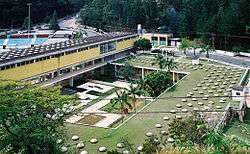Campinas Region
Campinas Region is a region in the state of São Paulo. Visiting this region is a step "off the beaten path" of Brazil, away from beaches and rainforests, an area of prosperous and developed towns, of beautiful mountain landscapes, and of rodeos and sertanejo music.
Regions
- Bragança Paulista (Águas de Lindóia, Amparo, Atibaia, Bragança Paulista, Joanópolis, Lindóia, Monte Alegre do Sul, Piracaia, Serra Negra, Socorro)
- Campinas (Americana, Campinas, Holambra, Indaiatuba, Jaguariúna, Mogi Guaçu, Mogi-Mirim, Valinhos, Vinhedo)
- Jundiaí (Jundiaí)
- Limeira (Araras, Limeira)
- Piracicaba (Águas de São Pedro, Piracicaba)
- Rio Claro (Analândia, Brotas, Rio Claro)
- São João da Boa Vista (Águas da Prata, Caconde, Casa Branca, São João da Boa Vista, São José do Rio Pardo)
Cities
- 🌍 Campinas - A major industrial hub, the third largest city in the state
- 🌍 Águas de Lindóia - Popular mineral spring resort town, also with eco-adventure options
- 🌍 Águas de São Pedro - Another popular mineral spring resort town, with one of the highest standards of living of the country
- 🌍 Amparo - Containing a remarkable historic center with several constructions from late XIX-early XX centuries
- 🌍 Holambra - Dutch settlement dubbed the "City of Flowers", due to it being South America's largest flower producer
- 🌍 Jundiaí - Open fruit farms, the Serra do Japi reserve and vivid memories of the state's railroad history
- 🌍 Piracicaba - City with a charming riverside area and one of the most beautiful universities in the country
- 🌍 Serra Negra - Mineral spring resort town with good views of the Mantiqueira mountain range
- 🌍 Socorro - Popular destination for locally made clothes and radical sports, offering also ecoutourism for people with disability
Other destinations
Understand
There is hardly a region of the state of São Paulo that represents its prosperity better than the Campinas region. The real development of the region started in the nineteenth century, with coffee plantations based on European immigrant labor. The coffee farming era left, as a legacy, a formidable network of railways, which would be the basis of the region's industrialization and populational growth beginning in the 1940s.
The region's most evident sign of economical strength is the Campinas metro area, a 2.8 million metropolis that streches along the Anhanguera and Bandeirantes motorways. Unlike Grande São Paulo, where the metropolis' economical power is highly concentrated in a small number of cities, the various cities that form the Campinas metro area compete evenly in economic development. Yet, the chaotic growth that happened after the 1950s in the state capital also affected the Campinas region, with poverty and criminality becoming a significant problem in some cities of the region.
Get in
Get around
By bus
The cities of the Campinas region can typically be reached by intercity buses, provided by various private operators. The cities of the Campinas metro area are also connected by metropolitan buses. A full list of metropolitan bus lines is available in the EMTU website.
By car
The Campinas region has a comprehensive network of motorways, maintained by either private operators, the São Paulo state or municipalities. As in the rest of the state, the roads with private operators have higher tolls but generally much better quality. Regardless, the road quality is overall quite higher than the Brazilian average, and non-pavimented roads are rare.
See
Do

- Visit the Paulista Water Circuit, a cluster of towns in the Serra da Mantiqueira mountain range famous for their mineral springs, which can be enjoyed at public baths or at certain hotels. They are a good place for relaxing, but offer other leisure options including historical heritage, ecotourism and family-friendly activities. It is composed of the cities of Amparo, Monte Alegre do Sul, Serra Negra, Lindóia, Águas de Lindóia, Socorro and Águas da Prata.
- Visit the Fruit Circuit, a popular regional tourism destination due to its wineries and fruit farms founded by European immigrants. Several of these farms are open to visitors, allowing you taste and buy local food and drinks. Alternatively, you can visit them during the yearly rural festivals and get in touch with São Paulo's immigrant culture. Cities of the Fruit Circuit include Jundiaí, Vinhedo, Indaiatuba, Morungaba, Atibaia and Valinhos.
- Feel the thrill of the rollercoasters of Hopi Hari, and the toboggans of Wet'n'Wild, in the Vida Completa SerrAzul (see Vinhedo).
- Cycle along the Barnabé river that crosses almost all the city of Indaiatuba.
- Enjoy the concerts of sertanejo music in the rodeos of Americana and Jaguariúna.
- Celebrate the caipira culture in the Festa de São João and other events in Joanópolis.
Eat
Drink
Stay safe
Go next